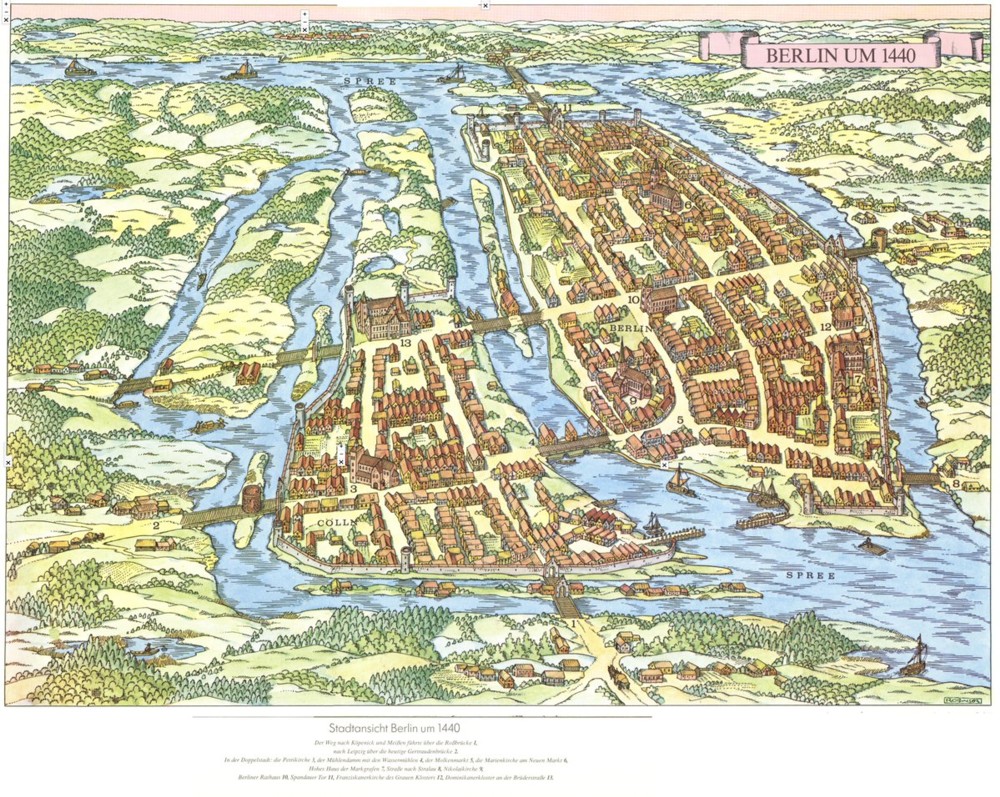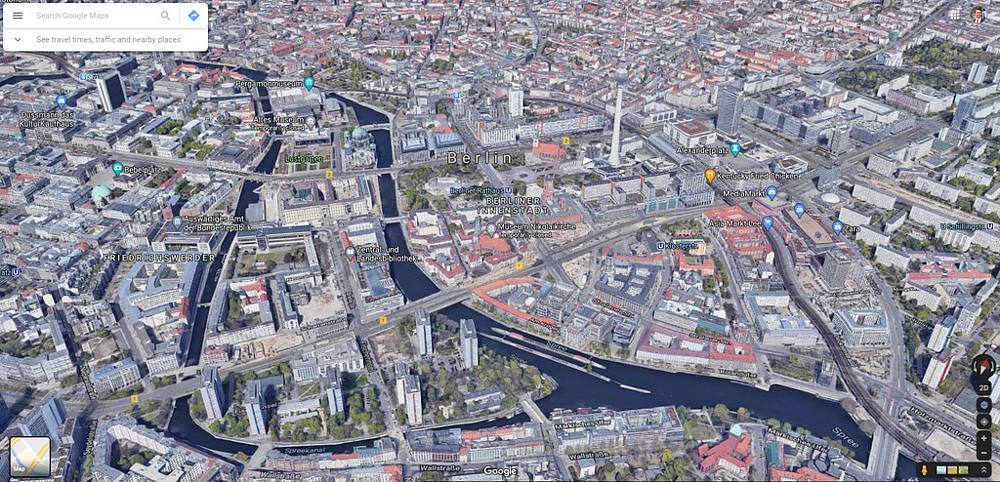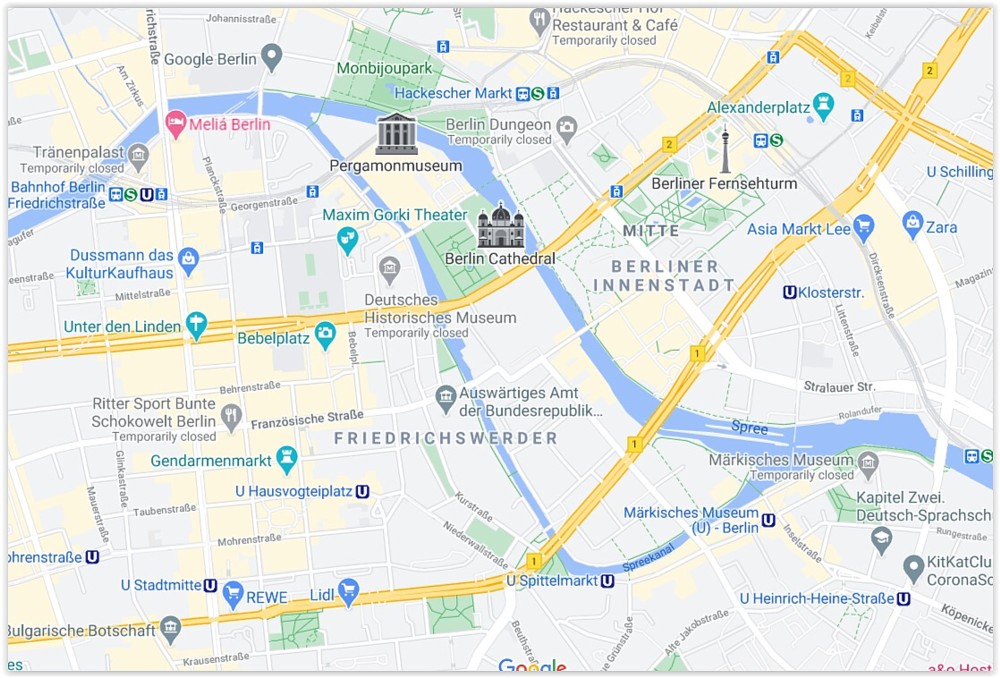Incoming from Michael Jennings:
Someone has helpfully provided a photo of the same section of Berlin …
I.e. (see the top of this posting) this section:
This being how this same section looks today:
Many thanks Michael. Michael knows everything about everywhere. But you have to express prior interest in the subject, as I did, which is a good system. If he told you everything about everywhere, all the time, just because he can, that might be a problem. But if he knows the subject interests you, he’s a mine of information. (Some of my best Last Friday of the Month meetings were addressed by him.)
It took me a while to find this place on the Google map of Berlin, but I did find it eventually:
The breakthrough came when, instead of looking only for water, I started looking for lots of bridges.
Like I say, when water does complicated and convoluted things, expect human habitation to be concentrated in that area.
That’s three times I’ve shown that Berlin in 1440 map here. What can I tell you? I like it.




The correspondence between the old map and the new photo is simply wonderful – and what is, I think, the Churfurstl Schloss (in different stages of development) appears in both – in the part of the “twin cities” identified as Cölln, rather than Altberlin. There is a rather splendid 1688 map of the area at https://en.wikipedia.org/wiki/C%C3%B6lln#/media/File:ZLB-Berliner_Ansichten-Januar.jpg
This isn’t something I knew. I have been to Berlin many times, but I had never thought about it this way until you posted that 1440 map (which I agree is wonderful) and I then went off to research it. In some ways that present image is more similar to the 1440 map than was the case at some times in between, because city walls and a moat were both built and demolished in the intervening period. Also, one of the branches of the river was turned into a city wall and then subsequently a railway, but is still recognisably there.
I had/have plans to visit Berlin again late next month, also. This is now very unlikely to happen. Soon, hopefully.
And I keep going down the rabbit hole. The “Churfürstl Schloss” (Elector’s Palace) is described by that name nowhere else I can find, but is usually referred to as the “Berliner Schloss”, which was the principal residence of the head of the House of Hohenzollern (who was Margrave of Brandenburg in 1440 but had risen to the title of Emperor of Germany by 1871 via being Duke and then King of Prussia), who was also an Elector of the Holy Roman Emperor in 1440. So I guess that checks out.
But, the palace was built between 1443 and 1451, so the person who drew the map may have been taking a certain amount of licence with the “in 1440” description, or the year was approximate.
And another but. Although the Berliner Schloss was the residence of the Hohenzollerns right up to their abdication as emperors of Germany in 1918, the building in the modern photograph is not the same building. That building was built between 2013 and 2020, so what looks like the oldest building in the photograph is actually one of the youngest.
The Berliner Schloss was bombed and damaged during the Second World War, but was apparently repairable. However, as they were prone to do, the East German government demolished it and the brutalist Palace of the Republic (the East German parliament) was built in its place. After German reunification, the Federal Republic demolished that building and after a lengthy debate the Berliner Schloss was rebuilt as an art museum, copying the exterior of the orginal building but apparently with an entirely modern interior. I shall have to go there once I can go to Berlin again.
“After German reunification, the Federal Republic demolished that building and after a lengthy debate the Berliner Schloss was rebuilt as an art museum, copying the exterior of the orginal building but apparently with an entirely modern interior.”
Sounds like more of one of my hobby horses, the Triumph of Modernism Indoors but Outdoors not so much.
The former East Germany may contain the most extreme examples of this. West Germany rebuilt fairly quickly after the war, and is therefore full of perfectly adequate, functional and structurally sound but relatively undistinguished buildings. East Germany was a mixture of showcase brutalism, grand ruins and empty spaces where grand buildings had been, right up to 1989. On top of that, you had a very by the book communist government that had a tendency to blow up cathedrals for ideological reasons and stuff like that. And the showcase brutalist buildings were often full of asbestos.
Then, a huge amount of money came along to rebuild everything after German reunification. It came along with modern requirements and modern health and safety standards too. Regardless of the age of the building being rebuilt, it wasn’t going to happen without modern wiring and plumbing, central heating and air-conditioning, wheelchair accessibility and modern levels of fire safety. This is all good, but it does mean that old fashioned interiors are not going to happen.
Also, Europe is full of art museums that were formerly palaces – the Louvre and the Hermitage being two of the most famous – and the fact that the buildings were not purpose-built as art galleries often causes problems. (The Louvre built an entirely new subterranean level and gutted much of the interior to cope with this, so that’s another example of your point). You are not going to rebuild the interior of a palace if it isn’t going to be used as a palace.
I’m now wondering what the interior of Notre Dame is going to look like in a few years.